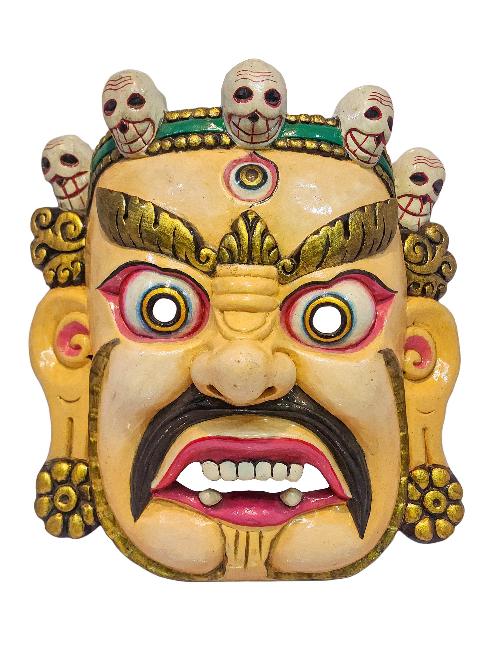Loading Content..

Black Mahakala is a prominent deity in Tibetan Buddhism, known for his fierce and wrathful form. Also called Bernakchen, he is revered as a protector and remover of obstacles. Black Mahakala is often depicted with a dark blue or black complexion, standing on a corpse, and wearing a crown of five skulls. He holds a trident, a skullcup, and a curved knife, symbolizing his power to destroy ignorance and negativity. Devotees believe that practicing Black Mahakala can help overcome obstacles, dispel negative energies, and cultivate inner strength and wisdom.
Iconography:
Black Mahakala is typically depicted with a fierce expression, dark blue or black, symbolizing his wrathful nature. He stands on a corpse, representing his triumph over death and impermanence. He has four arms, each holding a symbolic object. His main right hand wields a trident, representing his power over the three poisons of ignorance, attachment, and aversion. In his main left hand, he holds a skull cup filled with blood, symbolizing the transmutation of negative emotions. His remaining two hands hold a curved knife, representing the severance of ignorance, and a lasso, symbolizing the binding of negative forces.
History:
The origin of Black Mahakala can be traced back to ancient Indian Buddhism. In Tibet, he is considered to be an emanation of the Bodhisattva Avalokiteshvara, who embodies compassion. Black Mahakala became particularly popular during the time of the great Indian teacher Padmasambhava, who introduced tantric Buddhism to Tibet. Over the centuries, he gained significance as a protector deity in the Tibetan Buddhist tradition, and his practice spread widely throughout the region.
Temples:
Black Mahakala is widely revered in Nepal, and there are several temples dedicated to him. One notable temple is the Mahakala Temple in Patan, Nepal. Situated in the Patan Durbar Square, it is a sacred place where devotees gather to offer prayers and perform rituals to Black Mahakala. Another important temple is the Mahakala Temple in Kathmandu, located near the popular pilgrimage site of Swayambhunath Stupa. Both of these temples are significant pilgrimage sites for followers of Tibetan Buddhism.
Benefits of Practicing Black Mahakala:
The practice of Black Mahakala offers numerous benefits to practitioners. By connecting with this deity, individuals can overcome obstacles, both external and internal. Black Mahakala's wrathful form represents the transformative power to annihilate ignorance and destructive forces within oneself. Through devotion and practice, one can cultivate courage, inner strength, and wisdom. Additionally, practicing Black Mahakala is believed to purify negative karma, protect against harm, and promote spiritual growth on the path to enlightenment.
How to Practice:
The practice of Black Mahakala involves various aspects, including visualization, mantra recitation, and ritual offerings. Devotees often begin by visualizing Black Mahakala in front of them, vividly imagining his fierce form and the surrounding environment. Mantra recitation is an integral part of the practice, with the primary mantra being "OM BENZA MAHAKALA HUM PHAT," chanted repeatedly. Ritual offerings such as incense, flowers, and food can be made to Black Mahakala, expressing devotion and generating positive merit. Engaging in this practice regularly with sincerity and dedication deepens the connection with the deity.
Mantras of Black Mahakala:
The primary mantra associated with Black Mahakala is "OM BENZA MAHAKALA HUM PHAT." This mantra is recited to invoke the blessings and protection of the Black Mahakala. By chanting this mantra, devotees seek the removal of obstacles, the dispelling of negativity, and the cultivation of inner strength and wisdom. Along with the main mantra, there are other mantras and prayers specific to Black Mahakala's practice that can be found in Tibetan Buddhist texts and teachings. These mantras are considered potent tools for connecting with the deity and cultivating a deeper spiritual relationship.
Loading..
Please wait for the page to fully load for optimal functionality.
Loading Content..